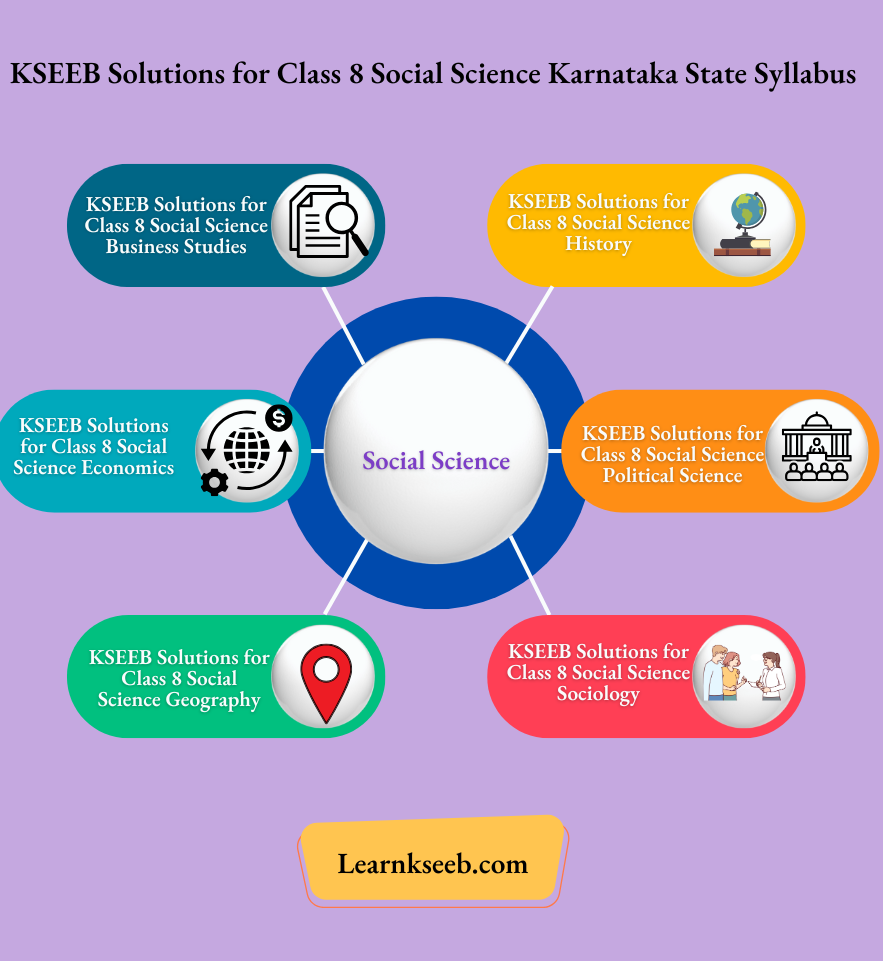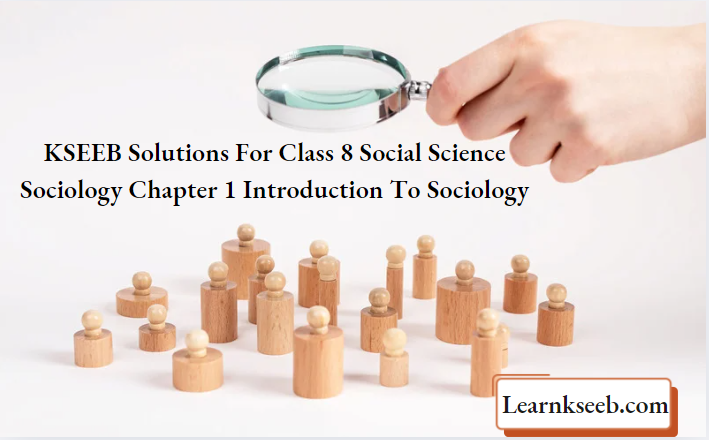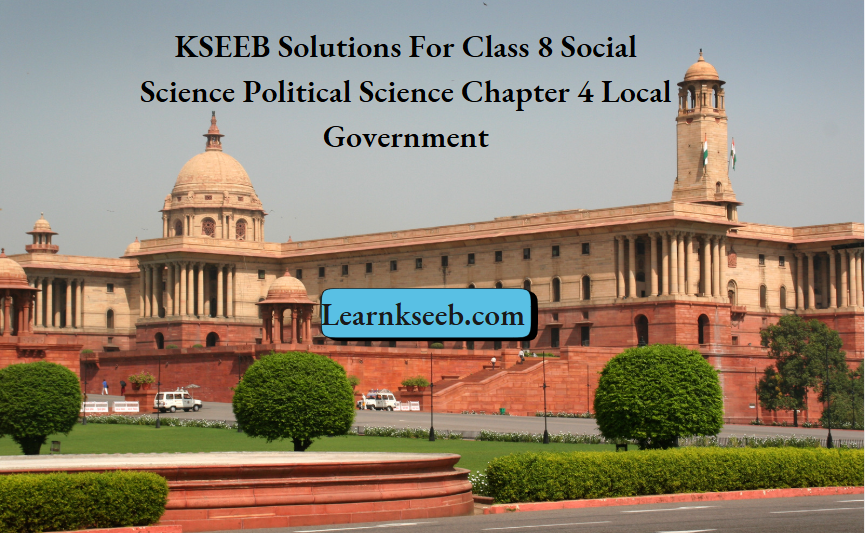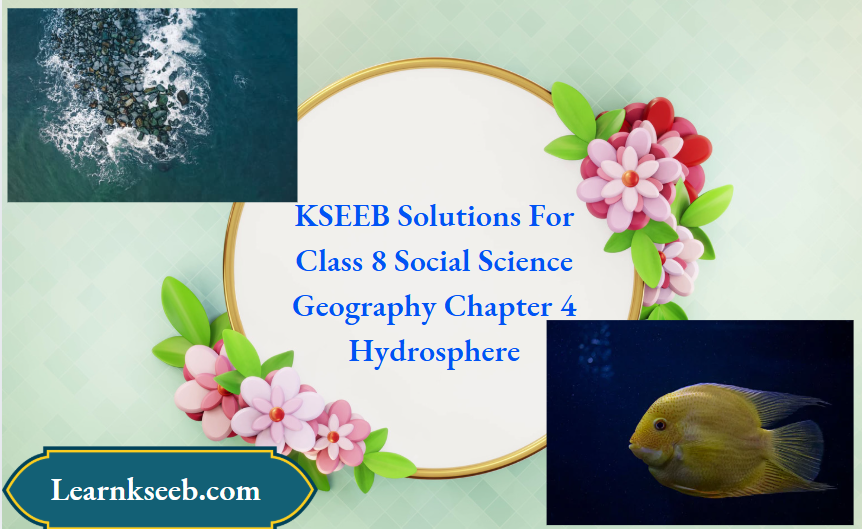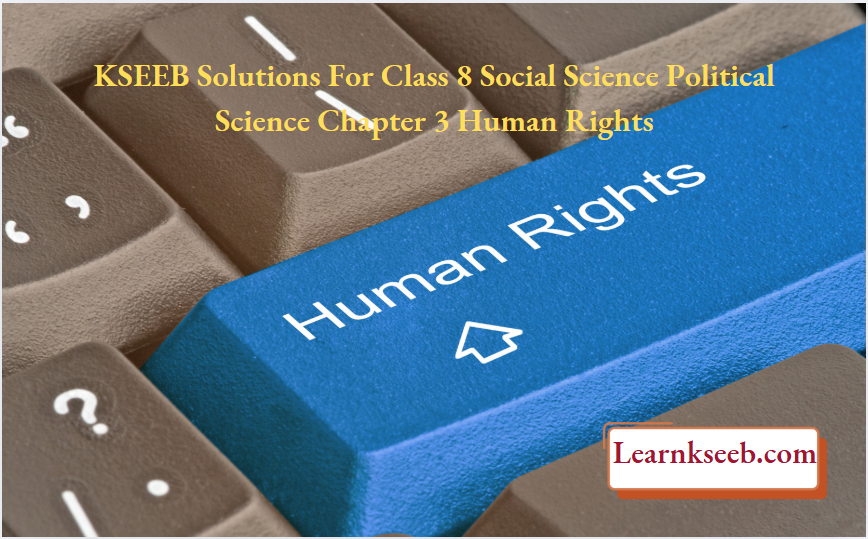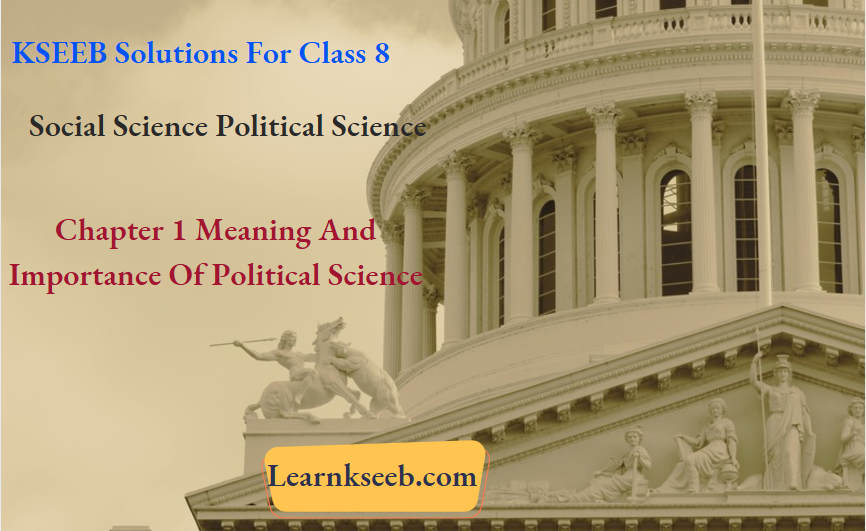KSEEB Solutions Class 8 Geography Chapter 2 Lithosphere Points To Remember
The outermost solid layer of the earth is known as the ‘Lithosphere’ (Litho means ‘rock’). Continents are parts of the lithosphere where different landforms like mountains, plateaus, plains, etc., are found. What is inside the earth is still a mystery for man. With years of study and research human beings have been able to get information about the materials inside the earth up to 10 to 12kms. Going beyond this depth is very difficult due to the increase in temperature.
On the basis of the density of the material, chemical composition, and physical state of matter the earth’s interior is classified into 3 main layers. They are the Crust, the Mantle, and the Core.
Read and Learn More KSEEB Solutions for Class 8 Social Science
The crust is the uppermost layer of the earth, rich in Silica, Aluminium, and Magnesium.
The Mantle is the second and the middle layer of the earth.
The materials are in a semi-liquid or partially molten state which is called magma.
The mantle has two parts
The upper mantle or the Asthenosphere is partially in a molten condition and
Lower mantle or the Mesosphere in solid condition.
The Core is the innermost layer of the earth. The most important materials of the core are Nickel and Ferrous (Iron). So it is known as NIFE.
Rocks are solid inorganic substances that are found in the crust of the earth.
On the basis of the mode of formation, rocks are classified into three types. They are:
- Igneous rocks,
- Sedimentary rocks and
- Metamorphic rocks.
The word ‘ Igneous’ means * fire’ derived from the Latin word ‘Ignis’ or Sanskrit word ‘Agni’.
Igneous rocks were the first to be formed, therefore they are also called Primary rocks.
When the molten materials (magma) of the Earth’s interior do not reach the earth’s surface, they cool and solidify (quite slowly) below the surface and are called intrusive igneous rocks.
Rocks formed by the solidification of magma above the earth’s surface are known as extrusive igneous rocks.
The rock materials in the liquid or molten state are called ‘magma’ and when it comes out from the earth are called lava.
The word Sedimentary is derived from the Latin word ‘SedimentunT, which means ‘settling down.
The sedimentary rocks are formed after the disintegration of igneous rocks. Therefore they are called secondary rocks. These rocks are also called aqueous rocks because they are formed in water bodies (Lake, Sea and Ocean beds).
Rocks are built up by fragments of pre-existing rocks which have been produced by the processes of weathering and erosion Examples:- Sandstone (Arenaceous rocks) and Shale (Argillaceous rocks).
Metamorphic rocks are those which are formed by the process of metamorphism or alteration of pre-existing rocks.
These are the forces which originate inside the crust and influence the surface features of the earth eg., Volcanoes, Earthquakes etc. The internal forces are also called Endogenic forces.
A volcano is a vent or narrow opening in the Earth’s crust connected by a pipe to an underlying magma chamber, through which magma, rock fragments, lava, ash, steam, flames and other gases are emitted from the interior of the Earth.
Class 8 Geography Lithosphere KSEEB Notes
The materials ejecting out from the volcanoes are of three types. Solid: Volcanic bombs, cinders, scoria, pumice, dust, ash. Liquid: Lava. Gases: Sulphur, Hydrogen, Carbon dioxide. An earthquake is a shock or series of shocks or tremors, due to a sudden movement of crustal rocks generated within the crust or mantle.
The point of origin of the earthquake in the earth’s crust is called the Seismic focus or Hypocentre.
A fault consists of a fracture in a rock along with a great deal of displacement takes place. Earthquakes occur when the movement of plates takes place along a line of fracture (San Andreas fault of California in the USA).
The magnitude and intensity of earthquakes are recorded by using the Richter scale.
A tsunami is a large sea wave occasionally experienced along the coasts of Japan and in other regions caused by an underwater earthquake. In the Japanese language ‘Tsunami’ means ‘harbour waves.
Weathering is the wearing away or breaking down or gradual disintegration of rocks by agents (Temperature, rainfall, wind etc.) present in the atmosphere.
When the rock is broken and disintegrated without any chemical alteration, the process is called Physical weathering or Mechanical weathering.
Chemical weathering is mainly brought about by the action of substances dissolved in rainwater. Living organisms like plants, animals and human beings play a role in one way or another in the weathering of rocks.
Denudation is the action of changing the landscape or changing the surface of the earth by various natural agents such as Rivers, Glaciers, Underground water, Wind, Sea waves etc.
A mass of fresh water flowing from its source to mouth along a definite course is called a ‘River’.
The place where a river takes its birth is called the ‘ Source’ and the ‘Mouth’ is the point where it meets the sea or ocean. ‘Tributaries’ are the feeders or small streams which supply water to rivers along their course.
The point where a tributary joins the main river is called ‘Confluence’.
Glaciers are slowly moving, compacted masses of ice and snow found in the high mountains and polar regions. The mass of ice or snow is pulled down by its weight due to the force of gravity.
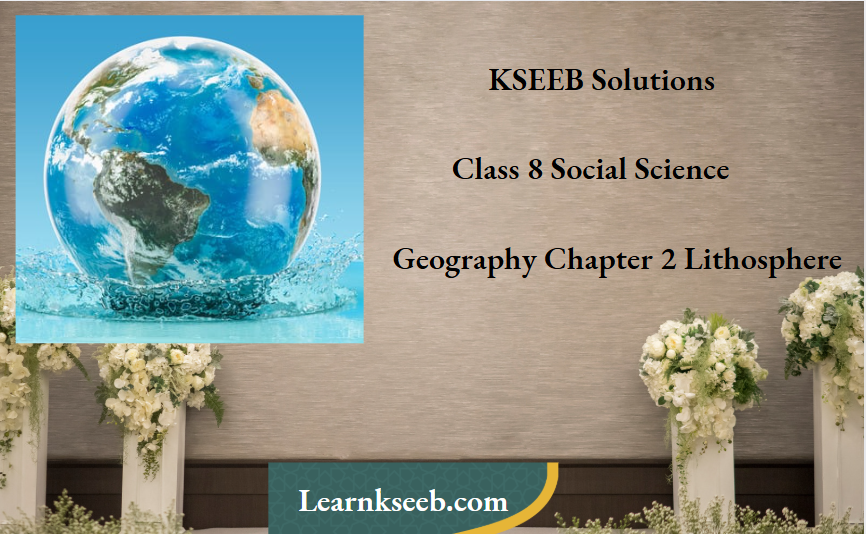
Lithosphere Exercises
Fill in the blanks with suitable words:
- The continental crust is also called SIAL.
- The vast basin-shaped volcanic mouth is Caldera.
- The most destructive earthquake waves are Surface Waves (LW).
- Stalactites and Stalagmites are most common in limestone regions.
- The Beaches are formed by sea waves work.
Lithosphere Answer the following Questions:
Question 1. Mention the three major layers of the interior of the Earth.
Answer: The three major layers of the interior of the Earth are the Crust, the Mantle and the Core.
Question 2. Name the types of volcanoes on the basis of the frequency of eruption.
Answer:
The types of volcanoes on the basis of frequency of eruption are:
Active Volcanoes
Dormant Volcanoes
Extinct Volcanoes
KSEEB Class 8 Geography Chapter 2 Questions And Answers
Question 3. Mention the important earthquake zones of the world.
Answer:
Earthquake Prone regions are:
The Circum-Pacific Belt – Regions around the Pacific Ocean (New Zealand, Philippines, Japan, USA, Peru etc.,).
The Mediterranean Belt – Regions around the Mediterranean sea.
The Himalayan Belt – The Siwalik region of India.
Question 4. What is weathering? Name the three main types of weathering.
Answer: Weathering is the wearing away or breaking down or gradual disintegration of rocks by agents (Temperature, rainfall, wind etc.) present in the atmosphere. The three main types of weathering are:
- Mechanical weathering
- Biological weathering
- Chemical weathering
Question 5. Name the landforms associated with the work of the river.
Answer: Gorges, canyons, V-shaped valleys, waterfalls (Angel falls, Niagara falls, Jog falls), Alluvial fans, Meanders, Flood plains, Natural levees, Oxbow lakes, Deltas (Sundarban delta, Nile delta) are the landforms associated with the work of the river.
Lithosphere Match the following:
A B
SIMA Earthquake
Sandstone Yellow soil
Epicentre Oceanic crust
Geyser Sedimentary rock
Loess Underground water
Answer:
A B
SIMA Oceanic crust
Sandstone Sedimentary rock
Epicentre Earthquake
Geyser Underground water
Loess Yellow soil
Lithosphere Define the following:
Aqueous rocks: Sedimentary rocks are also called aqueous rocks because they are formed in water bodies (Lake, Sea and Ocean beds).
Pacific ring of fire: This is the volcanic belt found in the Coastal margins of the Pacific Ocean consisting of the Philippines, Japan, USA, Central America, and South America.
Mechanical weathering: When the rock is broken and disintegrated without any chemical alteration, the process is called Physical weathering or Mechanical weathering.
Carbonaceous rocks: Organically formed sedimentary rocks
Tsunami: Tsunami is a large sea wave occasionally experienced along the coasts of Japan and in other regions caused by an underwater earthquake. In the Japanese language ‘Tsunami’ means ‘harbour waves.
Continental glacier: Continental glaciers are extensive ice sheets found in polar regions eg., Greenland and Antarctica.
Hot spring: Whenever warm or hot water comes out naturally it is called a hot spring or thermal spring. They are usually found near the volcanic regions
Lithosphere Terms to remember:
NIFE: The most important materials of the core are Nickel and Ferrous (Iron). So it is known as NIFE
Arenaceous and Argillaceous rocks: Rocks built up by fragments of pre-existing rocks which have been produced by the processes of weathering and erosion Example:- Sandstone (Arenaceous rocks) and Shale (Argillaceous rocks).
Tectonic forces: The earth’s crust consists of many major and minor plates. These plates are not stationary. The plate boundaries are dynamic places and are the primary location of earthquake activity (Circum-Pacific Belt).
Mountain glacier: The glaciers found in the Polar regions are called Mountain glaciers.
Aeolian cycle: The work of wind is called the “Aeolian cycle”.
Beaches: The work of sea waves is significant along the sea shore or coasts.
Lithosphere Additional Questions And Answers
Choose the correct alternative and Write the complete answer along with its alphabet in the sheet provided:
Question 1. The outermost solid layer of the earth is known as the
- Lithosphere
- Atmosphere
- Biosphere
- Hydrosphere
Answer: 1. Lithosphere
Question 2. Litho means
- Rock
- Solid
- Semi-solid
- Liquid
Answer: 1. rock
Question 3. The innermost layer of the earth is the
- Core
- Crust
- Mantle
- Gutenberg line
Answer: 1. core
Question 4. The word ‘Igneous’ means ‘fire’ which derived from
- The Latin word ‘Ignis’
- The English word ‘Ignis’
- The Greek word ‘Ignis’
- The French word ‘Ignis’
Answer: 1. The Latin word ‘Ignis’
KSEEB Geography Chapter 2 Class 8 Multiple Choice Questions
Question 5. Which one among the following is not an Intrusive igneous rock?
- Granite
- Diorite
- Gabbro
- Basalt
Answer: 4. Basalt
Question 6.Which one among the following is Extrusive igneous rock?
- Granite
- Diorite
- Gabbro
- Basalt
Answer: 4. Basalt
Question 7. The word Sedimentary is derived from the Latin word ‘Sedimentum’, which means
- Fragments
- Settling down
- Collecting
- Consolidation
Answer: 2. settling down
Question 8. The sedimentary rocks are also called aqueous rocks because they are formed in
- The water bodies
- The desert areas
- The mountain areas
- The plateaus
Answer: 1. The water bodies
Question 9. Mechanically formed sedimentary rocks are
- Arenaceous rocks
- Rock salt
- Gypsum
- Limestone
Answer: 1. Arenaceous rocks
Question 10. Chemically formed sedimentary rocks are
- Arenaceous rocks
- Argillaceous rocks
- Gypsum
- Limestone
Answer: 3. Gypsum
Question 11. Organically formed sedimentary rocks are
- Arenaceous rocks
- Argillaceous rocks
- Gypsum
- Limestone
Answer: 4. Limestone
Question 12.The funnel-shaped hollow at the top of the cone of a volcano is called
- ‘Vent’
- ‘Crater’
- ‘Caldera’
- Funnel
Answer: Question. Crater
Question 13. A large basin-shaped crater bounded by steep sides is known as
- ‘Vent’
- ‘Crater’
- ‘Caldera’
- Funnel
Answer: 3.‘Caldera’
Question 14. Which is an example of an Active volcano?
- Mt. Stromboli
- Mt. Vesuvius
- Mt. Fujiyama
- Mt. Krakatoa
Answer: 1. Mt. Stromboli
Question 15. Which is an example of a Dormant volcano?
- Mt. Stromboli
- Mt. Etna
- Arthur’s Seat
- Mt. Krakatoa
Answer: 4. Mt. Krakatoa
Question 16. Which is the example of an Extinct volcano?
- Mt. Stromboli
- Mt. Etna
- Arthur’s Seat
- Mt. Krakatoa
Answer: 3. Arthur’s Seat
Question 17.Japanese language ‘Tsunami’ means
- Cyclones
- Earthquakes in ocean
- Harbour waves
- Ocean tides
Answer: 3. Harbour waves
Question 18. Old Faithful in Yellowstone National Park of USA is an example for
- Hot springs
- Intermittent springs
- Geysers
- Artesian wells
Answer: 3. Geysers
Question 19. The springs which are common in Australia are
- Hot springs
- Intermittent springs
- Geyser
- Artesian wells
Answer: 4. Artesian wells
Question 20.“Aeolian cycle” is the work of
- Sea waves
- winds
- Glaciers
- Volcanoes
Answer: 2. winds
Lithosphere Fill in the blanks with suitable words:
- The point of origin of the earthquake in the earth’s crust is called Seismic focus or Hypocentre.
- The magnitude and intensity of earthquakes are recorded by using the Richter scale.
- The place where a river takes its birth is called Source.
- The point where a river meets sea or ocean Mouth.
- The point where a tributary joins the main river is called Confluence.
- “The work of river is called Fluvial Cycle”.
- The tidal mouth of a river broadening into the sea/ocean is Estuary
- A fan-shaped, low-lying area of deposits at a river mouth is Delta
- The work of Glaciers is called the “glacial cycle.”
Answer the following Questions in a sentence each:
Question 1. What is the Earth’s Crust?’
Answer: The crust is the uppermost layer of the earth, rich in Silica, Aluminium and Magnesium.
Question 2. What is the Mantle?
Answer: The Mantle is the second and the middle layer of the earth.
Question 3. Why is the More also called NIFE?
Answer: The most important materials of the core are Nickel and Ferrous (Iron). So it is known as NIFE.
Question 4. What are Rocks?
Answer: Rocks are solid inorganic substances that are found in the crust of the earth.
Question 5. Which are the three types of rocks?
Answer: Igneous rocks, Sedimentary rocks and Metamorphic rocks are the three types of rocks.
Class 8 Geography Chapter 2 Guide On Lithosphere KSEEB
Question 6. How is the word igneous rock derived?
Answer: Igneous rocks are those which have been formed by the cooling of molten matter of the earth. Igneous rocks were the first to be formed, therefore they are also called Primary rocks.
Question 7. Why igneous rocks are also called Primary rocks?
Answer: Igneous rocks were the first to be formed, therefore they are also called Primary rocks.
Question 8. How is the word Sedimentary derived?
Answer: The word Sedimentary is derived from the Latin word ‘Sedimentum’, which means ‘settling down.
Question 9. The sedimentary rocks are called secondary rocks. Why?
Answer: Sedimentary rocks are formed after the disintegration of igneous rocks. Therefore they are called secondary rocks.
Question 10. What are Endogenic forces?
Answer: Endogenic forces are the forces which originate inside the crust and influence the surface features of the earth eg., Volcanoes, Earthquakes etc.
Question 11. What is a volcano?
Answer: A volcano is a vent or narrow opening in the Earth’s crust connected by a pipe to an underlying magma chamber, through which magma, rock fragments, lava, ash, steam, flames and other gases are emitted from the interior of the Earth.
Question 12. What invent?
Answer: A passage in the earth’s crust through which magma and other volcanic materials are ejected is called a ‘Vent’.
Question 13. What are active volcanoes?
Answer: Volcanoes which constantly eject lava, gases, ashes etc., are known as active volcanoes.
Question 14. What is Earthquake?
Answer: An earthquake is a shock or series of shocks or tremors, due to a sudden movement of crustal rocks generated within the crust or mantle.
Question 15. What is the Epicentre?
Answer: The point on the earth’s surface vertically above the seismic focus is called the Epicentre.
Question 16. What is Seismograph?
Answer: The origin, time, velocity and direction of seismic waves are recorded by an instrument known as Seismograph.
Question 17. Mention the causes of the Earthquake.
Answer:
The causes of Earthquake are:
- Plate Tectonics
- Volcanic Eruptions
- Faulting
- Man-made factors
Question 18. Earthquakes are very dangerous and destructive. Why?
Answer: Earthquakes are very dangerous and destructive. They cause large-scale deaths, loss of property, landslides, flash floods, and damage to bridges, roads, railway lines etc.
Question 19. What is Denudation?
Answer: Denudation is the action of changing the landscape or changing the surface of the earth by various natural agents such as Rivers, Glaciers, Underground water, Wind, Sea waves etc.,
Question 20. What is a River?
Answer: mass of fresh water flowing from its source to mouth along a definite course is called a ‘River’.
Question 21. What are the tributaries?
Answer: ‘Tributaries’ are the feeders or small streams which supply water to rivers along their course.
Question 22. What are the Glaciers?
Answer: Glaciers are slowly moving, compacted masses of ice and snow found in the high mountains and Polar Regions.
Question 23. What is Underground water?
Answer: Underground water is the subsoil water found on account of percolation or seepage of water into the ground.
KSEEB Class 8 Lithosphere Study Materials
Question 24. What are aquifers?
Answer: The porous rock beds which hold large amounts of underground water are called aquifers.
Lithosphere Answer The Following Questions In Four or Five Sentences Each:
Question 1. What is inside the earth is still a mystery for man. Why?
Answer: With years of study and research human beings have been able to get information about the materials inside the earth up to 10 to 1Question km. Going beyond this depth is very difficult due to the increase in temperature (1 o C for every 3Question meters)
Question 2. How does man come to know about the earth’s interior?
Answer: To understand more about the earth’s interior humans are dependent on indirect evidence such as seismic waves, volcanic materials etc. The earth’s interior comprises various materials in different forms. On the basis of the density of a material, chemical composition and physical state of matter the earth’s interior is classified into 3 main layers. They are the Crust, the Mantle and the Core.
Question 3. Differentiate between SIMA and SIAL,
Answer: In the upper part of the crust only lighter materials are found. It is called SIAL (Silica and Aluminium) or continental crust. The lower part of the crust is rich in Silica and Magnesium and it is called SIMA or oceanic crust.
Question 4. Write extensions of the mantle.
Answer: The Mantle is the second and the middle layer of the earth. The depth of this layer is up to Question900 km from the surface. The materials are in a semi-liquid or partially molten state which is called magma. The mantle is composed of dense and rigid rocks which have a predominance of minerals like magnesium and iron. The mantle has two parts :
- The Upper mantle or the Asthenosphere is partially in a molten condition and
- The Lower mantle or the Mesosphere is in solid condition. The contact zone of the crust and the mantle is called ‘Mohorovicic Discontinuity’ or Moho. While the boundary that separates the Mantle from the Core is called ‘Gutenberg Discontinu-ity’. Here the rocks are different in chemical composition from those below and above.
Question 5. Differentiate between the Asthenosphere and the Mesosphere.
Answer:
The mantle has two parts:
- The upper mantle or the Asthenosphere is partially in a molten condition and
- The Lower mantle or the Mesosphere is in solid condition.
Question 6. Differentiate between Discontinuity and Discontinuity.
Answer: The contact zone of the crust and the mantle is called ‘Mohorovicic Discontinuity’ or Moho. While the boundary that separates the Mantle from the Core is called ‘Gutenberg Discontinu-ity’.
Question 7. How are Intrusive igneous rocks formed?
Answer: When the molten materials (magma) of the Earth’s interior do not reach the earth’s surface, they cool and solidify (quite slowly) below the surface.
Question 8. How are the Extrusive igneous rocks formed?
Answer: Rocks are formed by the solidification of magma above the earth’s surface
Solutions For Lithosphere KSEEB Class 8 Geography
Question 9. How are the Metamorphic Rocks formed?
Answer: Metamorphic rocks are those which are formed by the process of metamorphism or alteration of pre-existing rocks. Metamorphism means the change of form which may be physical or chemical or both by the influence of heat and pressure.
Question 10. What are the materials emitted by Volcanoes?
Answer: The materials ejecting out from the volcanoes are of three types. Solid: Volcanic bombs, cinders, scoria, pumice, dust, ash. Liquid: Lava. Gases: Sulphur, Hydrogen, Carbon dioxide.
Question 11. How are manmade activities responsible for Earthquakes?
Answer: Over interaction of man with nature. The extraction of minerals, deep underground mining, huge dams and reservoirs, nuclear tests etc.
Question 12. Where are the earthquake measuring stations in India?
Answer: Some seismic recording centres of India: Gowribidanur, Kodaikanal, Pune, Hyderabad, Dehradun
Question 13. Which are the Agents of Denudation?
Answer: Rivers, Glaciers, Underground water, Wind, Sea waves etc., are the Agents of Denudation
Question 14. Differentiate between ‘porous’ rocks and ‘impervious’ rocks.
Answer: The rocks which allow the water to percolate are called ‘previous’ or ‘porous’ rocks and the rocks which do not allow the water inside are called ‘impervious’ or non-porous rocks.
